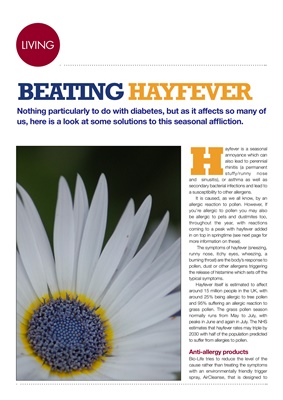
LIVINGLIVING
Nothing particularly to do with diabetes, but as it affects so many of
us, here is a look at some solutions to this seasonal affliction.
BEATING HAYFEVER
H
ayfever is a seasonal
annoyance which can
also lead to perennial
rhinitis (a permanent
stuffy/runny nose
and sinusitis), or asthma as well as
secondary bacterial infections and lead to
a susceptibility to other allergens.
It is caused, as we all know, by an
allergic reaction to pollen. However, If
you're allergic to pollen you may also
be allergic to pets and dustmites too,
throughout the year, with reactions
coming to a peak with hayfever added
in on top in springtime (see next page for
more information on these).
The symptoms of hayfever (sneezing,
runny nose, itchy eyes, wheezing, a
burning throat) are the body's response to
pollen, dust or other allergens triggering
the release of histamine which sets off the
typical symptoms.
Hayfever itself is estimated to affect
around 15 million people in the UK, with
around 25% being allergic to tree pollen
and 95% suffering an allergic reaction to
grass pollen. The grass pollen season
normally runs from May to July, with
peaks in June and again in July. The NHS
estimates that hayfever rates may triple by
2030 with half of the population predicted
to suffer from allergies to pollen.
Anti-allergy products
Bio-Life tries to reduce the level of the
cause rather than treating the symptoms
with an environmentally friendly trigger
spray, AirCleanse, that is designed to